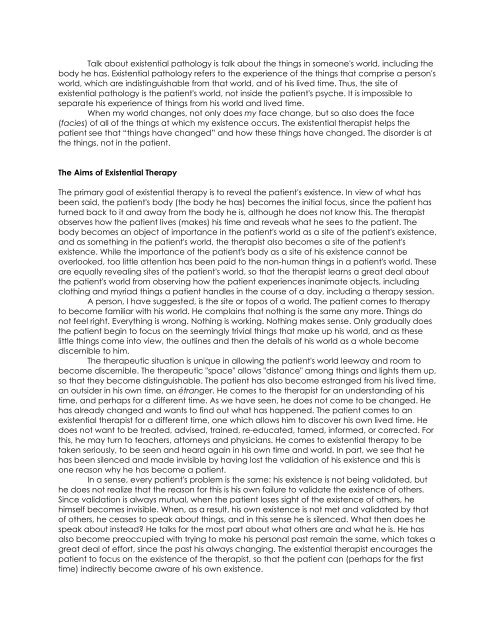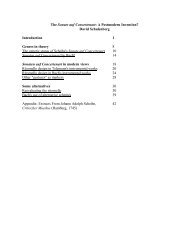SEVEN PAPERS ON EXISTENTIAL ANALYSIS ... - Wagner College
SEVEN PAPERS ON EXISTENTIAL ANALYSIS ... - Wagner College
SEVEN PAPERS ON EXISTENTIAL ANALYSIS ... - Wagner College
Create successful ePaper yourself
Turn your PDF publications into a flip-book with our unique Google optimized e-Paper software.
Talk about existential pathology is talk about the things in someone's world, including the<br />
body he has. Existential pathology refers to the experience of the things that comprise a person's<br />
world, which are indistinguishable from that world, and of his lived time. Thus, the site of<br />
existential pathology is the patient's world, not inside the patient's psyche. It is impossible to<br />
separate his experience of things from his world and lived time.<br />
When my world changes, not only does my face change, but so also does the face<br />
(facies) of all of the things at which my existence occurs. The existential therapist helps the<br />
patient see that “things have changed” and how these things have changed. The disorder is at<br />
the things, not in the patient.<br />
The Aims of Existential Therapy<br />
The primary goal of existential therapy is to reveal the patient's existence. In view of what has<br />
been said, the patient's body (the body he has) becomes the initial focus, since the patient has<br />
turned back to it and away from the body he is, although he does not know this. The therapist<br />
observes how the patient lives (makes) his time and reveals what he sees to the patient. The<br />
body becomes an object of importance in the patient's world as a site of the patient's existence,<br />
and as something in the patient's world, the therapist also becomes a site of the patient's<br />
existence. While the importance of the patient's body as a site of his existence cannot be<br />
overlooked, too little attention has been paid to the non-human things in a patient's world. These<br />
are equally revealing sites of the patient's world, so that the therapist learns a great deal about<br />
the patient's world from observing how the patient experiences inanimate objects, including<br />
clothing and myriad things a patient handles in the course of a day, including a therapy session.<br />
A person, I have suggested, is the site or topos of a world. The patient comes to therapy<br />
to become familiar with his world. He complains that nothing is the same any more. Things do<br />
not feel right. Everything is wrong. Nothing is working. Nothing makes sense. Only gradually does<br />
the patient begin to focus on the seemingly trivial things that make up his world, and as these<br />
little things come into view, the outlines and then the details of his world as a whole become<br />
discernible to him.<br />
The therapeutic situation is unique in allowing the patient's world leeway and room to<br />
become discernible. The therapeutic "space" allows "distance" among things and lights them up,<br />
so that they become distinguishable. The patient has also become estranged from his lived time,<br />
an outsider in his own time, an étranger. He comes to the therapist for an understanding of his<br />
time, and perhaps for a different time. As we have seen, he does not come to be changed. He<br />
has already changed and wants to find out what has happened. The patient comes to an<br />
existential therapist for a different time, one which allows him to discover his own lived time. He<br />
does not want to be treated, advised, trained, re-educated, tamed, informed, or corrected. For<br />
this, he may turn to teachers, attorneys and physicians. He comes to existential therapy to be<br />
taken seriously, to be seen and heard again in his own time and world. In part, we see that he<br />
has been silenced and made invisible by having lost the validation of his existence and this is<br />
one reason why he has become a patient.<br />
In a sense, every patient's problem is the same: his existence is not being validated, but<br />
he does not realize that the reason for this is his own failure to validate the existence of others.<br />
Since validation is always mutual, when the patient loses sight of the existence of others, he<br />
himself becomes invisible. When, as a result, his own existence is not met and validated by that<br />
of others, he ceases to speak about things, and in this sense he is silenced. What then does he<br />
speak about instead? He talks for the most part about what others are and what he is. He has<br />
also become preoccupied with trying to make his personal past remain the same, which takes a<br />
great deal of effort, since the past his always changing. The existential therapist encourages the<br />
patient to focus on the existence of the therapist, so that the patient can (perhaps for the first<br />
time) indirectly become aware of his own existence.















